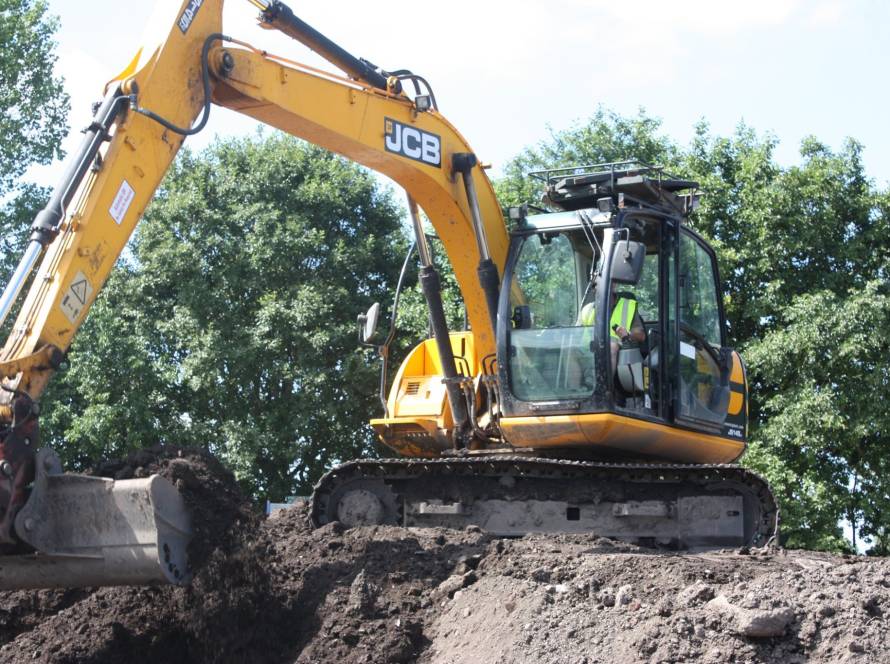The 360 Excavator is a key piece of machinery on most construction sites and particularly on groundwork sites. A 360 Excavator can be a dangerous tool when used incorrectly but can be used with great safety when an operator has been trained well and follows all safety precautions. Learning the controls to move the digger is essential as operators should always have complete control over the machine. This guide will not train you to operate the 360 excavator and you shouldn’t try to if you haven’t been trained to do so. We offer training on the 360 excavator Accredited to NPORS or CPCS which can be booked through our website.
Pre Start Checks Before Operating
Before operating any plant machinery, you should always conduct a Pre Start Check. This will be slightly different for all machines.
Your Pre Start checks should cover a range of parts of the excavator. This will help to reduce the risk of injuries or accidents on-site. If you see something that isn’t right during your Pre Start Checks, report it to the nearest manager or supervisor, do not operate the machine.
The checks will involve checking the tracks to make sure they are not damaged or they haven’t loosened. If the tracks have any sort of damage, they could break off and cause the machine to slip or fall. You will also need to check the back and underside of the cab to make sure there are no leaks, cracks or dents. The hydraulics will also need to be checked, if they are dirty or oily, it could suggest that there is a leak.
You can read our guide on Pre Start checks to find out all of the best practices.
The 360 Excavator Cab
You’re ready to get in the cab now that you’ve conducted your Pre Start Checks. Getting in the excavator itself requires your focus though as there are still hazards to manage.
3 Points of Contact
You’ll see a step on the side of the tracks, this step is to allow the 3 points of contact that should always be used when entering and exiting the cab.
The 3 points of contact help to reduce injuries for operators that can occur from high vibration exposure whilst operating.
Firstly, you should place your foot on the step on the side of the tracks while holding the safety bar. Next, step up onto the top of the track and finally step into the cab.
More Safety…
By now you’re probably sick of the safety checks and you could be tempted to just turn the key and get started. However, even if you decide to stop reading and do just that, you might find that the 360 Excavator won’t turn on.
That’s because a lot of machines have safety features to prevent operators from working unsafely. Firstly, you’ll need to put your seat belt on. This is often the reason that the machine won’t start. The door of the cab should also be closed, however, quite often the cab door can be left open.
The Controls
You’re now ready to switch the machine on and begin using the controls. Turn the key to switch on the excavator and you will begin to hear it startup.
The controls of the 360 Excavator consist of 2 joysticks and 2 pedals/levers. These are used to control various parts of the 360 Excavator.
The Right Joystick is used to controls the Boom and the Bucket. By pushing the right joystick to the right, the bucket will open. By doing the opposite and pushing the joystick left, the bucket will close. Be careful while doing this as the safety stop features can only prevent so much from damaging the machine. If you hear a loud bang while moving the arm, it will often mean that you have over opened the bucket.
Pulling the right joystick back will raise the arm, this is useful when positioning the bucket above the area you are about to excavate. Doing the opposite and pushing the joystick forward will lower the arm.
Raising and lowering the arm is different from extending and retracting the stick. The stick is the end of the excavator’s arm that is closer to the bucket. By pushing the left joystick forward you can extend the stick arm and by pulling it back, you can retract it.
By moving the left joystick left and right, you will rotate the cab around the tracks. The cab of the excavator will turn a full 360 degrees, but make sure to remember your orientation as facing backwards will mean you have to reverse the excavator for you to move in the direction you are facing.
Finally, you will have 2 pedals/levers in front of you. These are used to control the tracks of the 360 excavators. For a beginner, you should try to use these separately to the arm. The pedals can be used with your feet like the pedals in a car, however, there is also the option to use your hands to move the levers attached. This makes the machine more accessible for novice users to learn. The tracks will move separately from each other but can be moved in conjunction if both pedals are pressed.
Excavation Best Practices
So now, you’re probably ready to let loose and tear up the ground around you and leave everything you touch in a state of complete destruction. You should now learn the best practices for digging to make sure that you don’t end up on the wrong end of a prosecution case.
Excavation is not as easy as smashing the bucket into the ground and ripping out chunks of earth. There are ways that will improve the effectiveness of the machine as well as reduce wear and tear.
For beginners, it is easier to begin with a further away excavation. Extend the arm and boom to a level where the bucket is around 1 metre above the ground. The bucket teeth should be roughly level with the end of the arm but the teeth should be slightly lower. This will remove the chance that the arm will make contact with the ground.
Lowering the arm and then closing the bucket will then allow the excavator to break the ground. Once you have filled the bucket, you should use the left joystick to retract the stick. This will bring the bucket towards you with the spoil inside. Now rotating the cab, you can find an area to dispense the spoil.
The safety systems within the excavator can only protect you so much. There are several hazards that are still present at all times, even while sitting in the cab. Being careful of your bucket is essential as it has the power to destroy the things that it touches, including the excavator itself! Being careful of your tracks and cab is essential as the bucket can collide with both. In this event, you could bring the bucket through the cab or completely take the tracks off the machine.
With all of the health and safety requirements to operate an excavator and the amount of knowledge that is required, you should consider taking a course with SB Skills. We advise a novice course if it is your first time operating an excavator and you can book it online.
Alternatively, call 01695 558 420 or email us with the enquiry box below.
Error: Contact form not found.



